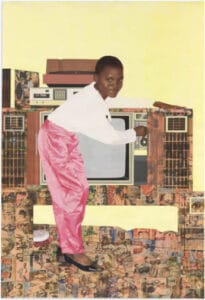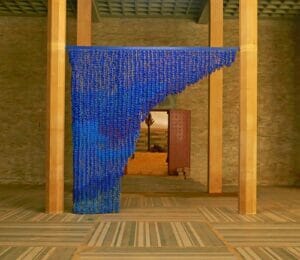Analysis of the Akuaba dolls
Akua’ba: the quest for aesthetic perfection
The Akua’ba figure, striking for the purity and elegance of its lines, is simply composed of a large disk-shaped head atop a stylized body with arms but no legs. The perfection of the head, held elegantly high above a ringed, often elongated neck, is underscored by the symmetry of the features, with clearly defined eyes, eyebrows, nose, and mouth. The stylized arms are held wide open, as if to embrace the person who carries this fertility doll on her back like a baby… as the figure is indeed an amulet, worn in accordance with the norms of a matrilineal society in which female power is expressed through pregnancy and childbirth. So Akua’ba dolls need female attributes, as the family line is perpetuated through the mother in the Ashanti culture.
Akua’ba dolls are prescribed by the okomfo (traditional priest) for barren and pregnant women alike, in the former case to encourage fertility, in the latter to ensure the beauty of the future child. Worn daily for a period of several months, the dolls need to be flat and not too big – about eight inches tall on average, so that they can easily be slipped inside the folds of a garment. These fertility dolls are usually carved from a hard, black wood called osese, carefully polished by the craftsman. The presence of legs on Akua’ba figures seems to be a recent twentieth-century addition and is an unusual feature that represents a break with the traditional aesthetic.

The legend of the Akua’ba
How to bring good luck
Like any other legend, the founding myth of Akua’ba fertility dolls has variations, but always tells the story of a young woman named Akua who was tormented by her inability to conceive. Her only hope was to beg for the help of an obosom (deity) by visiting a temple. There she met an okomfo who told her to have a doll carved. Once it was made, the priest consecrated it and entrusted it to Akua, instructing her to care for it and carry it on her back, just as mothers usually do with their babies. Akua followed the okomfo’s advice, paying no heed to the spiteful comments and mockery of her community. A few months later, she gave birth to a child, ba, a little girl of such beauty that she put Akua’s detractors to shame. And that is how Akua’ba, Akua’s daughter, initiated the tradition of fertility dolls. All the women who wanted to conceive or to ensure the beauty of their babies began to carry them.

There is an obvious connection between these dolls and the quest for both fertility and beauty. The Akua’ba shows all the features that characterize beauty in the Ashanti culture: the round head with a slightly flattened skull, recalling the massage of an infant’s soft cranial bones to gently form the round shape associated with perfection; the small scarifications under the eyes, to protect against convulsions; the neck with rings representing rolls of fat, a sign of good health, beauty, and prosperity. The wooden Akua’ba doll is, hopefully, impregnated with these qualities, guaranteeing a strong and good-looking family line handed down through matrilineal descent.
Ron van Doorn et Herbert M. Cole, Akua’ba Asante, Wednesday Child, Akuaron, 2021 Robert Sutherland Rattray, Religion & Art in Ashanti, Clarendon Press, Oxford, 1927



